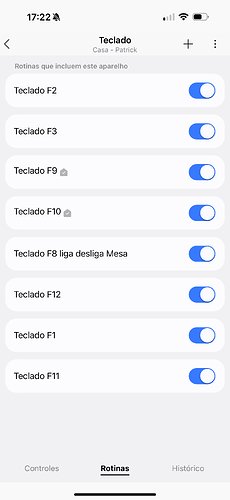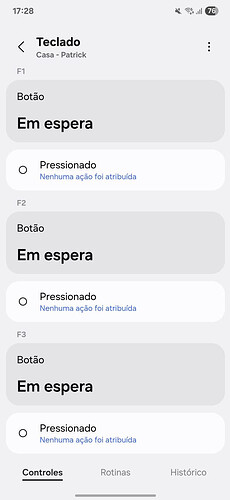Europe is getting all the Matter smoke detector love
The MSH450 hub and smoke detectors work together as part of a connected security system. When smoke is detected, the detector emits an 85dB alarm (audible at over 3 metres), and the hub follows with a 110dB alert, activating all connected alarms. Automations can be set to switch off high-power devices to help reduce the risk of further fire hazards. When combined with door or motion sensors, the smoke detector can also function as a siren during unauthorised entry. This option to use the siren in a smoke detector is something that many have asked for before, so it could be a winner for those hankering for that extra functionality.
My system (Frient smoke detectors, Woox sirens with battery backup, motion and contact sensors) already does exactly that. Everything is handled by the SmartThings Home Monitor.
First PC Keyboard with Matter Support from Thirdreality | Products | matter-smarthome
And this is the typical Matter problem today…
(Emphasis added)
The exact behavior depends on the target platform. In Apple Home, for example, the F-keys can be assigned multiple actions based on short, long, or double presses. However, the smart home platform in use must support Matter buttons in general. Thirdreality lists Apple Home, SmartThings, and Home Assistant as examples.
Sigh…![]()
Sometimes I have the feeling that you don’t like Matter.
In another thread, we’re discussing a very basic Z-Wave device that’s missing a feature, because the driver doesn’t support it. Or look at all the Zigbee certified devices that need special handling on a Zigbee certified SmartThings hub…
It’s not the fault of Matter, where the certification process is way more strict than Zigbee, for example. It just needs time to fully implement it on the platforms.
Ever written an edge driver?
For this specific device, they rewrote the button handling in the Matter driver. From now on every similar device should work out of the box. It’s a long process, but it’ll get better (more flexible) over time.
A lot of stuff is going on in the Matter thermostat driver to support pretty much every Matter HVAC device in the future.
I like the Matter standard.
I like the matter concept, which was supposed to mean that consumers who were not tech savvy would only have to to find the Matter logo on the box and then they could buy it with confidence that when they took it home, it would work with their platform of choice, whether it was Alexa, Google home, Apple Home, SmartThings, Ikea, or any of the other participating platforms.
That’s the part where the rollout of matter has failed, as most analysts covering the industry have noted. Right now, just having the Matter logo on the box does not tell you whether the device will work with the major matter supporting platforms.
Exactly like this new keyboard. It works with Apple home in one way. It works with smartthings and Home Assistant in another way. And at the time of this posting, it doesn’t work with Alexa or Google Home.
I understand why that’s true, as I know you do, but it’s not what the Matter standards organization promised.
The matter logo program has not made it much easier to shop for these devices, even for power users.
The CSA website states
This industry–unifying standard is a promise of reliable, secure connectivity. It is a seal of approval that devices will work seamlessly together – today and tomorrow. Matter creates more connections between more objects, simplifies development for manufacturers, and increases compatibility for consumers.
Elsewhere on the same page, it states that matter “simplify the purchasing process…” Only it hasn’t yet.
Build With Matter | Smart Home Device Solution - CSA-IOT
So that’s the source of my disappointment. The logo doesn’t mean what they promised. Maybe someday, but not now. There is no minimum requirement on a matter controller for which parts of the specification it will support. Or even a timeline for when. So the consumer is left having to research each individual device in depth to figure out whether it will in fact work with the setup they have at home or not. Regardless of the logo on the box. ![]()
The thing is that when a customer buys a product with a Matter logo on it and it doesn’t work out of the box with - say - SmartThings, it’s basically SmartThings’ fault. It’s a bug and should be reported.
![]()
That’s true, but as an engineer I would also argue that it’s the fault of the matter standards organization, the CSA, for allowing matter controllers to use the matter logo even though the controller manufacturer has not yet implemented the full matter standard. Or committed to doing so.
I have no problem with the matter specification or the use of the matter logo on the individual devices that match that specification.
But the independent standards organization caved to the demands of the major platforms that they be allowed to pick and choose which parts of the specification their matter controllers would support. While still letting them use the same matter logo.
I would at least like to see a new matter logo released for the matter controllers that says “in development“ or “beta“ or something to indicate that it’s not yet the full matter specification. So that the ones that do support the full specification could be rewarded for doing so. And customers could be alerted that they’re going to have to do more individual research for the ones that don’t support the full specification.
Sort of like the way Zwave introduced the “Z wave plus“ logo to identify the controllers and devices that had the additional newer features.
JMO, of course.
Couldn’t agree more. But I think that the CSA/Matter Group is already aware of this.
It’s tricky since Matter certifies that devices are conformant to the protocol, but Matter doesn’t specify how the user interface should be.
Google Home for instance doesn’t allow creating automations with Matter buttons from the Google Home app, but you can develop an app using the Google Home API and use Matter button events to create an automation. So, from the technical point of view, they support Matter buttons. From the practical point of view we can agree they don’t.
Same goes for SmartThings and the Matter API for Edge drivers or Home Assistant and their Matter server. Internally pretty much everything is supported and it’s compliant with the protocol, but the user interface for certain features is not a nice graphical user interface but a low-level programming interface.
I’ve been using it for 30 days. It’s working great on Smartthings.
I understand the complaint about Matter, but in this case of the keyboard, with 12 keys, why want more? hahahahah
They show up as individual edge child devices?
Haven’t had a look at the driver after it was merged.
For some reason I expected the worst.
How I found out that @Automated_House has a YouTube channel:
Subscribed!
ha, good thing you posted that. I don’t get on Xwitter any more, so I never would have seen it. I started on TikTok and Instagram, but have been leaning more into YouTube lately. Thanks for the follow!



